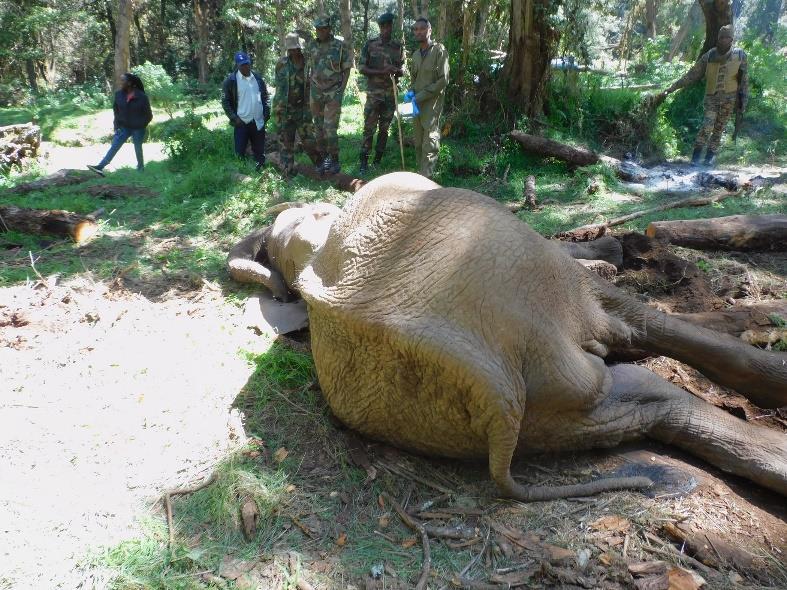
SWT/KWS MERU MOBILE VETERINARY UNIT
JANUARY 2024




JANUARY 2024




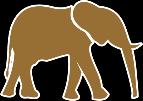
In January, the Meru ecosystem experienced early mornings characterized by intense sunlight and heightened daytime temperatures. The once lush grasslands and shrubs gradually lost their vibrant-green pigmentation. However, the team was encouraged by the increased sighting of baby elephants which instilled optimism that the existing forage and water would adequately support wildlife over the coming months. The SWT/ KWS Meru Mobile Veterinary Unit responded to 6 cases in January. In Bisanadi National Reserve, the unit successfully treated an adult elephant bull for an elbow dislocation. In Meru National Park, the team rescued an abandoned male buffalo calf, and successfully reunited it with its mother. The team also successfully treated a reticulated giraffe bull with a wire around its neck and administered annual rabies and DHLP booster vaccines to a female security dog. In Mt. Kenya National Reserve, the veterinary team attended to a recumbent elephant bull. Unfortunately, the elephant bull was unable to stand despite the team’s valiant efforts Given the elephant’s poor body condition and grave prognosis, it was put to rest to alleviate further pain and suffering
The Meru Mobile Veterinary Unit is grateful for the generous financial support it continues to receive from Sylvie Chantecaille through the Sheldrick Wildlife Trust. The team also sincerely thanks Kenya Wildlife Service for providing crucial managerial oversight and logistical support, led by the Senior Assistant Director-Eastern Conservation Area and the Head of KWS-Veterinary Services Department. The Unit also appreciates the efforts of all other conservation partners and individuals who reported wildlife cases and supported veterinary interventions.

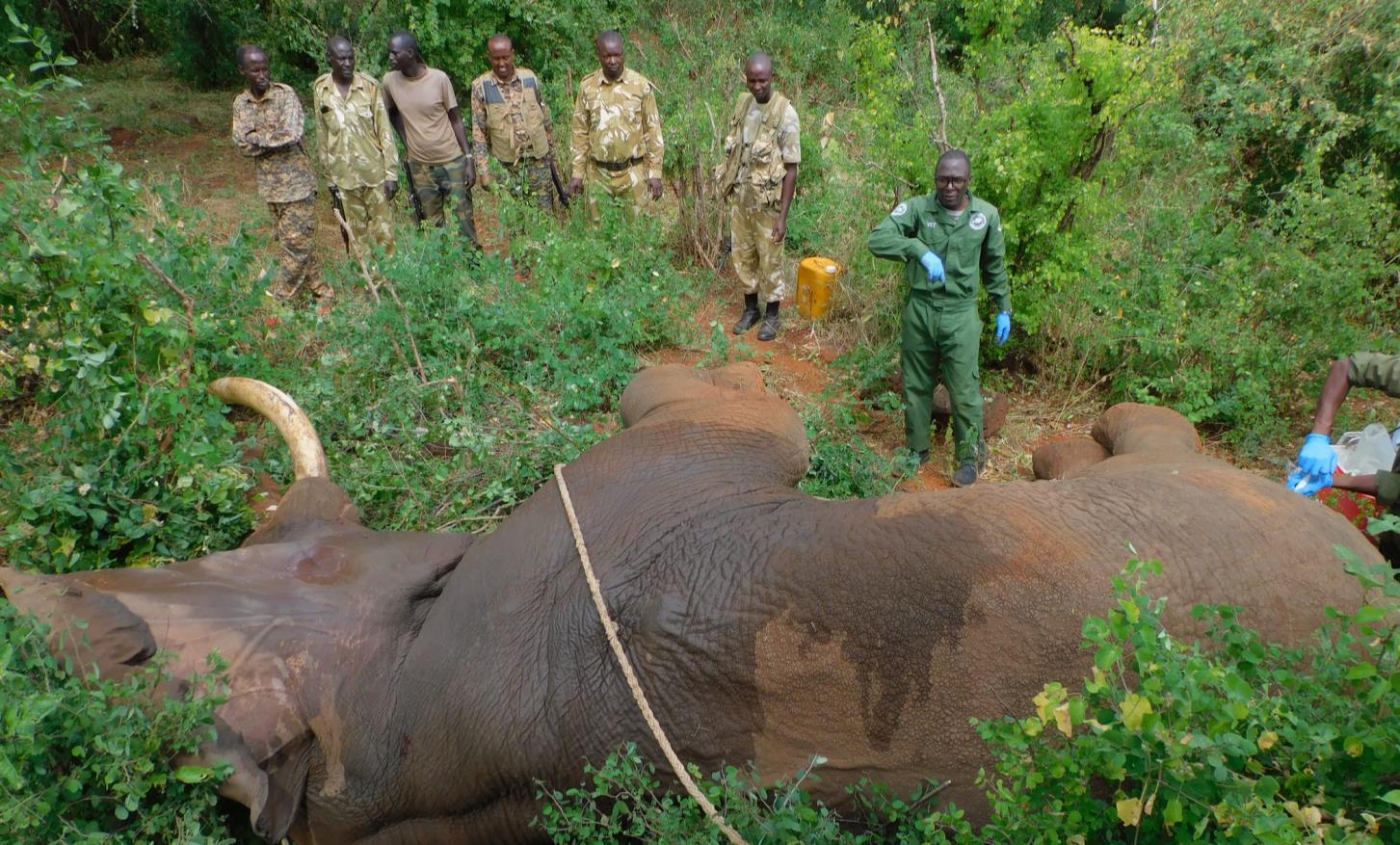
While on patrol, KWS officers came across an adult elephant bull in distress and informed the veterinary unit The elephant displayed very little activity and was isolated from the rest of the elephant herd. Immobilisation, examination and treatment
The Meru Mobile Veterinary team found the elephant in an area with dense vegetation. The team observed that the bull displayed signs of lameness and favoured his left forelimb. He was darted from a vehicle with 18mgs Etorphine and was fully immobilized after 5 minutes Upon assuming recumbency, he was promptly secured, doused with water, and his trunk was straightened to ensure airways were unobstructed. The elephant was found to be in good overall health with a body condition score of 3.5 out of 5. However, the elephant had an elbow dislocation in the left forelimb that resulted in significant swelling at the joint. To address inflammation, 1,500 mg Flunixin meglumine, and 3,000 mg Cyanocobalamin were administered intramuscularly. Anaesthesia was then reversed with 250 mg Naltrexone administered through a prominent ear vein. The elephant was carefully helped to rise with the assistance of a vehicle.
The elephant has a good prognosis. Ground teams will monitor the elephant's progress and follow-up treatment will be administered if necessary.
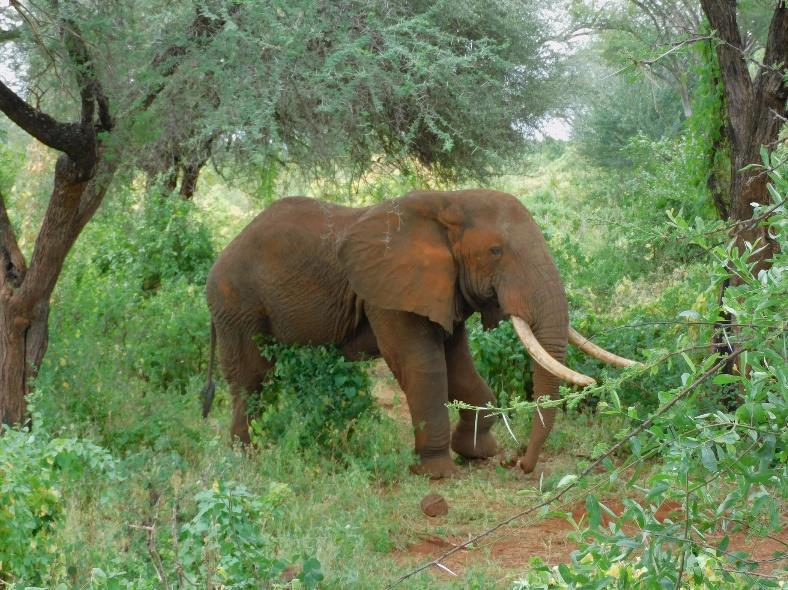

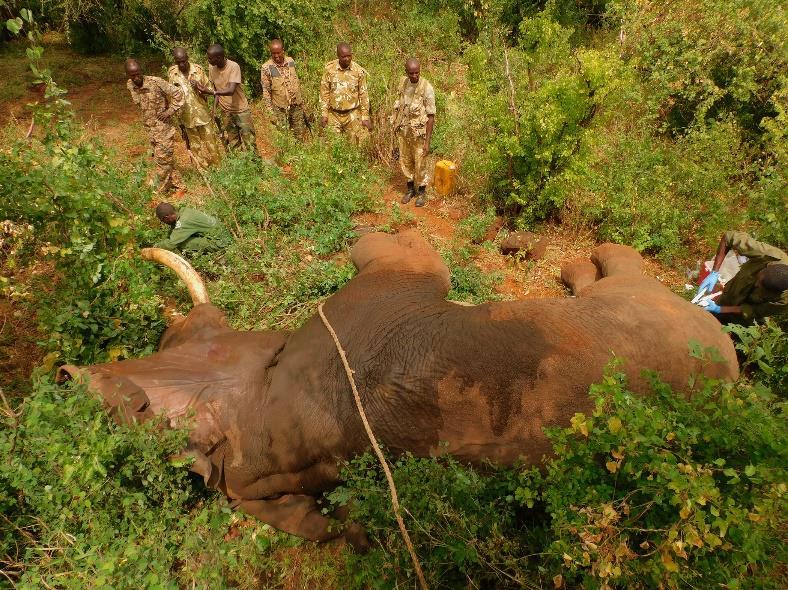
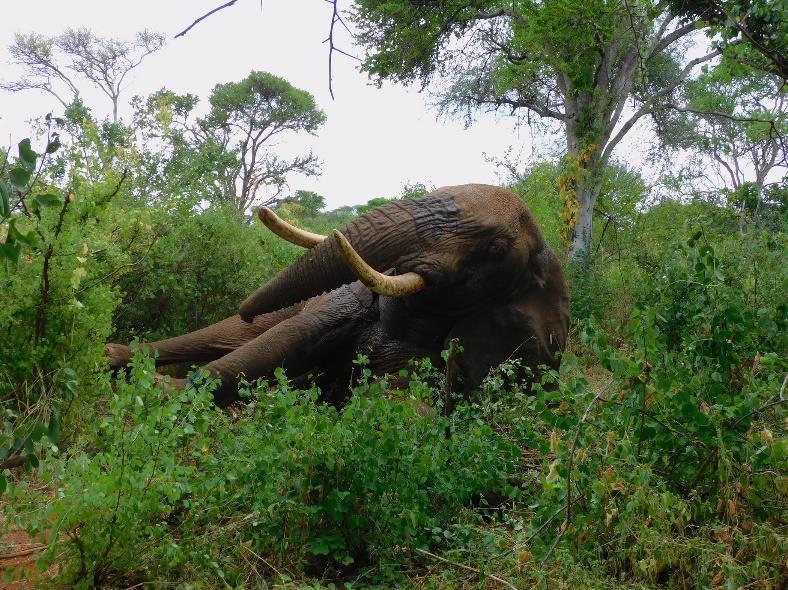
On 18/01/2024, a post-mortem examination was conducted by the Meru Mobile Veterinary Unit team on the carcass of a juvenile female black rhinoceros found in Borana Wildlife Conservancy.
The rhino carcass was found in the Ngare Ndare riverbed with notable fauna activity on the steep riverbank proximate to the carcass indicative of potential descent by the rhino calf. Prior to the arrival of the veterinary team, the trophies had been collected and secured by the Kenya Wildlife Service team for safekeeping.
External examination revealed extensive scavenging and autolysis of the internal organs. Assessment of the integumentary system did not reveal any significant injuries. Internally, haemorrhages were identified around the cranial and pelvic regions accompanied by generalized reddening of the remaining internal organs consistent with concurrent internal bleeding.
Based on the autopsy findings, the cause of death was determined to be exsanguination due to cranial and pelvic injuries suspected to have occurred upon falling from height.
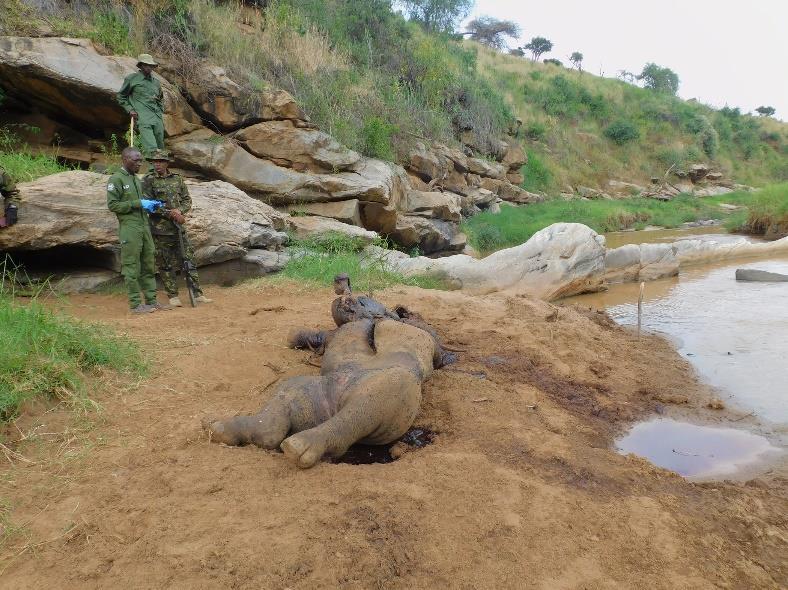
The Meru Mobile Veterinary Unit was informed that a tour guide had sighted a solitary buffalo calf in the park with no buffalo herd in the vicinity. The team promptly responded and proceeded to the specified location with the objective of facilitating the reunion of the calf with its maternal herd.


The buffalo calf was found alone suggesting an inadvertent mother-calf separation during the herd's movement. Subsequently, the calf was physically restrained and examined. The calf was noted to be in good body condition and estimated to be one week old and still dependent on maternal milk. Post-examination, oral rehydration was administered. The calf was then relocated to a shaded environment to mitigate the effects of the intense sun. Diligent efforts were employed to locate the buffalo herd and after an exhaustive search, the team found a distressed female buffalo standing apart from its herd. Upon sighting the calf, the distressed cow promptly rushed to its side resulting in the successful reunion of the two. They then both rejoined the herd with a good prognosis indicated for their well-being.
The buffalo calf was re-united with its mother, both mother and calf have a good prognosis.


The SWT/KWS Meru Mobile Veterinary Unit was informed by Mr. Kitavi Kaloki, the Assistant Director- Meru National Park, about the sighting of an adult Reticulated giraffe bull with a tight snare around its neck. Immobilisation, examination and treatment
The snared giraffe bull was found in a tower of about 15 giraffes in a densely vegetated area. The animals were herded towards a slight opening to facilitate darting. The snared giraffe was darted with 14 mgs Etorphine combined with 30 mgs Azaperone. The 1st dart malfunctioned and didn’t discharge prompting the use of a 2nd dart with the same dosage. The drugs took effect 10 minutes later, and the giraffe was safely roped to the ground, blindfolded to prevent ocular damage and visual excitation, and manually restrained by pinning its head and neck to the ground. Anaesthesia was immediately reversed with 250mgs Naltrexone administered via the jugular vein. The wire snare was then cut loose with wire cutters. Luckily, the snare had not inflicted significant injuries on the animal’s neck. The abrasion wounds caused by the snare were covered with an antibiotic aerosol and intramuscularly 40 mgs Dexamethasone sodium was administered intramuscularly to manage inflammation. The giraffe was released 10 minutes later and ran away.
Prognosis
The Reticulated giraffe bull has a good prognosis
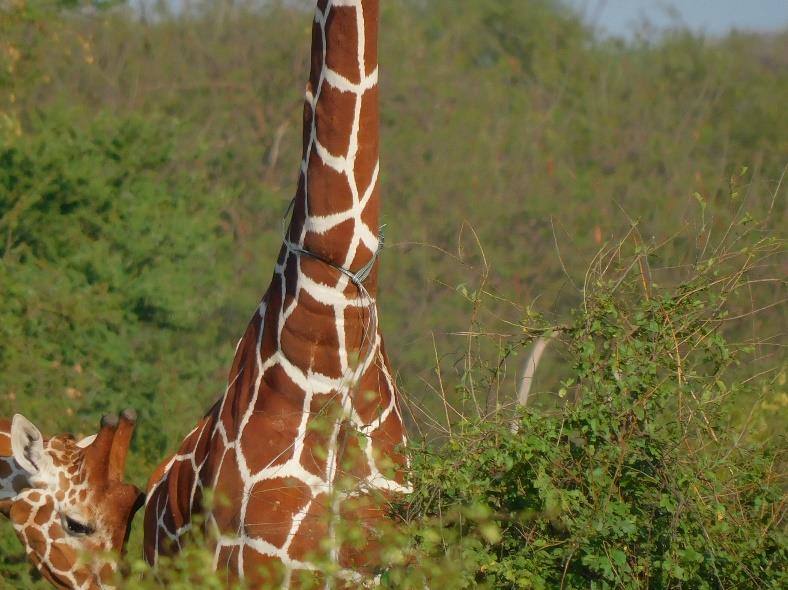
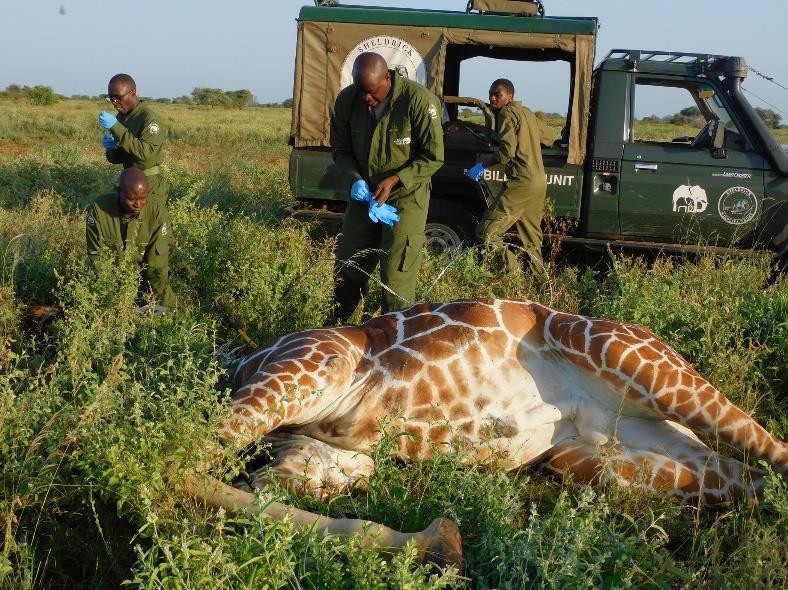


Security dogs play a pivotal role in wildlife conservation efforts, contributing significantly to the protection of endangered species and their habitats. These highly trained canines serve as invaluable assets in tracking and apprehending poachers, detecting illicit wildlife products, and patrolling conservation areas. Given their close interaction with wildlife, it is imperative that security dogs receive annual vaccinations, particularly for rabies and DHLP (Distemper, Hepatitis, Leptospirosis, Parvovirus). These boosters are essential not only to safeguard the health and well-being of the dogs but also to prevent the potential transmission of infectious diseases between wildlife and domestic animals. Ensuring the continued health and immunity of security dogs through routine vaccinations enhances their effectiveness in supporting wildlife conservation initiatives while minimizing health risks to both the animals and the ecosystems they protect.
The Meru Mobile Veterinary Unit vaccinated Packer, an adult female Dutch shepherd security dog, against rabies and DHLP.
Packer was given an opportunity to become acquainted with the veterinarian to prevent agitation and facilitate a thorough health check. During the examination, it was observed that she had gained a notable amount of weight, displayed energy, alertness, and had a shiny, smooth coat. She was gently held in place by hand while receiving subcutaneous rabies and DHLP vaccinations on the dorsal side of the neck.
Prognosis
There were no negative reactions observed post-vaccination, Packer has a good prognosis.
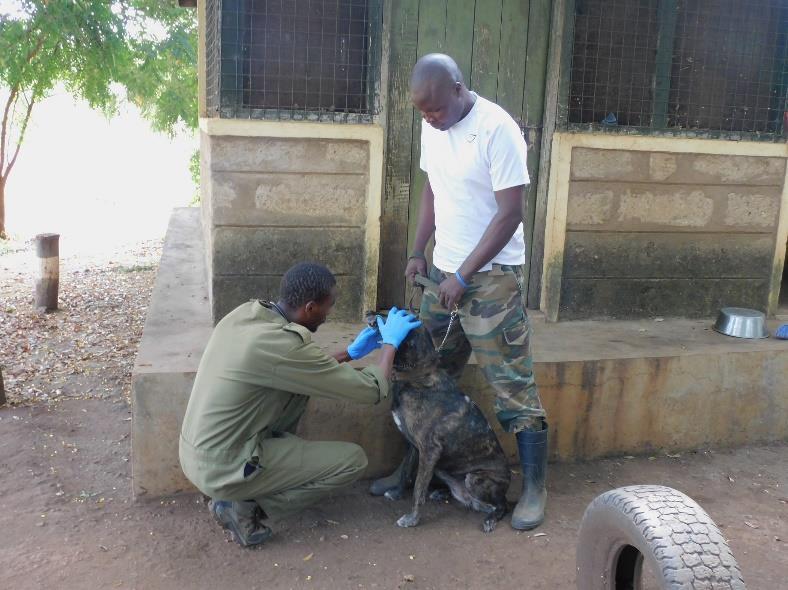

On 29/12/2024, the Meru Mobile Veterinary Unit was informed about a recumbent male elephant in the Marania area of Mt. Kenya National Reserve.
The elephant was found in a debilitated state with a body condition score of 2/5. This was characterized by a prominent vertebral ridge along the backbone, lumbar depression, clearly visible pelvic bones with a gradual sunken area in front and a flattened area behind, and non-visible ribs covered by an exceedingly thin layer of fat. Additionally, pale and dry mucus membranes were observed in the ocular and oral regions. Rectal examination indicated minimal faecal material, suggesting a state of starvation.
The elephant was generously doused with water to cool its body, 40mg Dexamethasone sodium was administered intramuscularly to manage shock. Both intravenous and rectal infusion methods were employed to facilitate rehydration and restore electrolyte balance. Despite these interventions and efforts to facilitate the elephant's return to an upright position, it remained recumbent. Considering the animal’s compromised body condition and its grave prognosis, it was put to rest to alleviate further pain and suffering.
The autopsy carried out post-euthanasia found that the elephant had signs of malnutrition attributed to inadequate feed consumption that resulted in overall body wasting. Inadequate nutrition and hydration led to the development of anaemia, contributing to cardiomegaly, hepatosplenomegaly, and the compromised function of various vital organs. This impaired the normal physiological processes. Additionally, diminished energy levels likely contributed to generalized weakness, incoordination, and recumbency in the animal. Samples were collected for further laboratory analysis.

